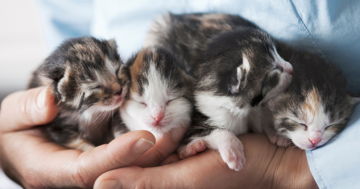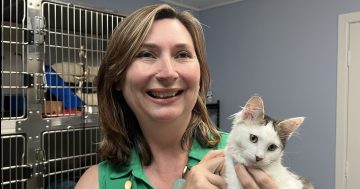
Cat containment is a hot issue in the ACT. After reading John Hargreaves’ piece last week, I’d like to explore a few arguments in more depth and also address some misconceptions about cat containment.
There are three types of cats: domestic, stray, and feral. I think everyone knows that a domestic cat is a pet. A stray cat is a cat that lives on the streets and has limited amounts of human interaction. For example, the Woden drain cats are strays. Feral cats are truly wild cats, they live in the bush, have never had contact with humans and they have to hunt all their food. I know some would argue that the Woden drain cats are feral because they’re born onto the streets, but they don’t really have to hunt as a survival method if they would either find scraps of discarded food, or perhaps be fed by members of the community.
All cats are natural hunters. It’s in their instinct. Feral cats actively hunt for their food because they have to do it to survive. I’ve spent time observing stray cats in colonies and because they have a semi-decent food source, they don’t show much interest in hunting wildlife. They obviously still do it, most cats can’t resist pouncing on a smaller moving object, but their motivations aren’t as deep as those of a feral cat.
Domestic cats are similar. If something comes into their path they’ll probably jump on it. One of the points raised in John’s article and in the comments was about the distance cats can wander. It honestly depends on the cat. Some cats can roam 5 kilometres, others will wander next door and then come back.
I am pro cat containment for all pet cats. While not all cats have an active interest in hunting and some will not venture far from their couch, we cannot have separate rules for separate cats. We have to generalise and assume all cats roam and all cats hunt.
Cat containment is good for so many reasons. Aside from the preservation of wildlife, cat containment keeps your beloved feline safe from dogs, traffic, those who derive joy out of torturing animals, baits and poisons, and safe from other wildlife such as possums or snakes. Keeping your cat contained will also lower the risk of it catching diseases like feline immunodeficiency virus which can lead to Feline AIDS.
Yes, foxes, wild dogs and wild pigs also harm our wildlife. But we need to tackle each problem thoroughly and if that means doing it one at a time and starting off with cats – a species we have a greater control over than say, wild pigs – then that’s what we have to do. Fixing some is better than fixing none. Rome wasn’t built in a day and all that.

I have two cats. One is two years old and has extreme anxiety, so is happy to stay indoors and occasionally venture to our courtyard (while supervised) to lie in the sun and nibble on some cat grass. My other cat is six or seven months old. He LOVES going outside. You open the door for three seconds and he bolts out and over the courtyard fence. Fortunately our private courtyard backs onto a communal courtyard, so he is contained for the time it takes for me to bring him back. I’m still renting so can’t have a cat run built yet (bring on home ownership!), so I taught my littlest cat to walk on a leash. Yup, a leash. It’s possible to allow your cat outside time while still protecting them, and protecting our wildlife.

The Government recently said that all inclusive cat containment would need to be introduced over a long period of time (probably around 10 years) to allow current cat owners to adjust (building cat runs/cat enclosures or transitioning their cat to the indoor lifestyle) and also so people intending on future cat ownership would know the policy was coming. Cats can live a perfectly happy and healthy lifestyle indoors with no behavioural problems as long as they get love from their humans and have sufficient mental stimulation.
We can’t keep every single cat off the streets or eradicate them in the wild, but cat containment would make a big difference. However, practical measures need to be put in place in the form of funding for cat desexing subsidies.
It is near impossible to keep an undesexed cat inside when they’re on heat. I know of a cat on heat that actually busted out of a screen window – she pulled the whole thing out, screws and all (unstoppable, this particular cat also only has three legs!)
Undesexed cats are also more likely to roam. As I said earlier, feral cats cause the most damage to wildlife. However, if undesexed cats are roaming around they will breed with stray cats and the stray cats will eventually breed with feral cats. The long term goal should be all domestic cats desexed and contained as well as Trap Neuter Release programs for stray and feral cats.
Desexing is mandatory in the ACT, however, the procedure can cost over $400 and some people can’t afford that. Any kind of government policy around subsidised desexing will take time to implement, no matter how many online petitions there are. Immediate action is needed so I’m working on a project called Canberra Cat Fix which raises money so low income households in Canberra will be able to have their cats desexed before next kitten season.
Our aim is to raise at least $6000 so we can desex around 50 cats. While this doesn’t seem like many, it will potentially prevent thousands of kittens from being born. The more cats we can desex, the less cats we’ll have on the streets which will mean less risk of spread of disease, and a greater chance of survival for our wildlife.
We’re doing this because you can’t teach your cat about safe sex.
Canberra Cat Fix can be found on Facebook here.
You can donate to the Canberra Cat Fix here.
















